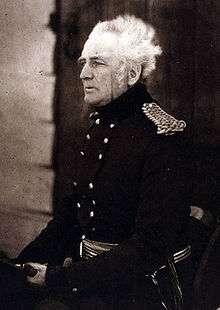George Brown (British Army officer)
General Sir George Brown, GCB, KH, PC (Ire) (3 July 1790 – 27 August 1865) was a British soldier notable for commands in the Peninsular War and the Crimean War.

- For others of this name, see George Brown (disambiguation).
Sir George Brown | |
|---|---|
 Sir George Brown, photographed by Roger Fenton in the Crimea in 1855 | |
| Born | 3 July 1790 Linkwood, Elgin, Scotland, Great Britain |
| Died | 27 August 1865 (aged 75) Linkwood, Elgin, UK |
| Allegiance | |
| Service/ | |
| Rank | General |
| Commands held | Light Division |
| Awards | Knight Grand Cross of the Order of the Bath Knight of the Royal Guelphic Order |
Background
Brown was born the son of George Brown, Provost of Elgin, at Linkwood, near Elgin, Scotland and educated in Elgin.
Military career
He obtained a commission in the 43rd (Monmouthshire) Regiment of Foot (Light Infantry) (later the 1st Battalion, Oxfordshire and Buckinghamshire Light Infantry) in 1806, and he was promoted to lieutenant a few months later. He saw active service for the first time in the Mediterranean and at Copenhagen, 1806 and 1807. The 43rd was one of the earliest arrivals in Spain when the Peninsular War broke out, and Brown was with his regiment at Vimeiro, and in the Corunna retreat. Later in 1809 the famous Light Division was formed, and with Craufurd he was present at all the actions of 1810–1811, being severely wounded at Talavera; he was then promoted captain and attended the Staff College at Great Marlow until (late in 1812) he returned to the Peninsula as a captain in the 85th. With this regiment he served under Major-General Lord Aylmer at the Nivelle and Nive, his conduct winning for him the rank of major.
The 85th was next employed under General Robert Ross in America, and Brown, who received a severe wound at the action of Bladensburg, was promoted to a lieutenant colonelcy. At the age of twenty-five, with a brilliant war record, he received an appointment at the Royal Horse Guards, and remained in London for over twenty-five years in various staff positions. He was made a colonel and Knight of the Royal Guelphic Order in 1831, and by 1852 had arrived at the rank of lieutenant general and the dignity of Knight Commander of the Order of the Bath In 1850 he was appointed Adjutant-General to the Forces,[1] but following the appointment of Lord Hardinge to the post of commander-in-chief, Brown left the Horse Guards in 1853.
In 1854, on the despatch of a British force to the East, Sir George Brown was appointed to command the Light Division. This he led in action, and administered in camp, on Peninsular principles, and, whilst preserving the strictest discipline to a degree which came in for criticism, he made himself beloved by his men. At Alma he had a horse shot under him. At Inkerman he was wounded whilst leading the French Zouaves into action. In the following year, when an expedition against Kertch and the Russian communications was decided upon, Brown went in command of the British contingent. He was invalided home on the day of Lord Raglan's death (29 June 1855). He was later promoted general, backdated to 7 September 1855.[2] From March 1860 to March 1865 he was appointed Commander-in-Chief, Ireland and was the Colonel-Commandant of the 2nd Battalion Rifle Brigade from 1855 to 1863.
Honours included CB in 1838, a KCB in 1852, a GCB in 1855, and a Knight of the Royal Guelphic Order (KH).[3]
He died at his birthplace of Linkwood in 1865.
Honorary appointments
- Colonel of the 77th (East Middlesex) Regiment of Foot (1851–1854)
- Colonel of the 7th (Derbyshire) Regiment of Foot (1854–1855)
- Colonel of the 32nd (The Cornwall) Regiment of Foot (Light Infantry) (1863–1865)
- Colonel-in-Chief of The Prince Consort's Own Rifle Brigade (1863–1865)
References
- "No. 21085". The London Gazette. 18 April 1850. p. 1052.
- "No. 6586". The Edinburgh Gazette. 8 April 1856. p. 325.
- "Not One in Ten Thousand Know Your Name: the Officers of the British 1st Battalion of Detachments in 1809 -- Lieutenant George Brown 43rd Foot". The Napoleon Series. Retrieved 17 July 2016.
![]()
External links
| Wikimedia Commons has media related to George Brown (general). |
| Wikisource has the text of the 1911 Encyclopædia Britannica article Brown, Sir George. |
| Military offices | ||
|---|---|---|
| Preceded by Sir John Macdonald |
Adjutant General 1850–1853 |
Succeeded by Sir George Cathcart |
| Preceded by Sir John Macleod |
Colonel of the 77th Regiment of Foot 1851–1854 |
Succeeded by Sir George Goldie |
| Preceded by Sir Edward Blakeney |
Colonel of the 7th (Royal Fusiliers) Regiment of Foot 1854–1855 |
Succeeded by Samuel Auchmuty |
| Preceded by Sir Harry Smith |
Colonel-Commandant of the 2nd Battalion, The Prince Consort's Own Rifle Brigade 1855–1863 |
Succeeded by Sir Charles Yorke |
| Preceded by The Lord Seaton |
Commander-in-Chief, Ireland 1860–1865 |
Succeeded by The Lord Strathnairn |
| Preceded by The Viscount Melville |
Colonel of the 32nd (The Cornwall) Regiment of Foot (Light Infantry) 1863–1865 |
Succeeded by William George Gold |
| Preceded by The Lord Seaton |
Colonel-in-Chief of The Prince Consort's Own Rifle Brigade 1863–1865 |
Succeeded by Sir Edward Blakeney |